Optical Imaging Deformation Inspection and Quality Level Determination of Multifocal Glasses
Abstract
1. Introduction
2. Literature Review
3. Research Method
3.1. Image Capture and Image Preprocessing
3.2. Feature Representation
3.3. Deformation Detection by a Slight Deviation Control Scheme
3.4. Quality Level Determination of Deformation Severity by the Fuzzy Inference System
3.4.1. Fuzzy Inference System of Deformation Levels
3.4.2. Adaptive Neuro-Fuzzy Inference System for Determining Quality Level of Deformations
3.4.3. Genetic Algorithm (GA)-Based Adaptive Neuro-Fuzzy Inference System for Determining Quality Level of Deformations
4. Experiments and Results
4.1. Performance Assessment of Various Line Thicknesses in the Concentric Circle Patterns
4.2. Performance Assessment of Applying EWMA Slight Deviation Control Scheme
4.3. Performance Assessment of Using Distinct Norm Patterns in Deformation Detection by the Suggested Method
4.4. Robustness Tests on Changing the Brightness of the Image Illumination for Deformation Detection Results by the Suggested Approach
5. Conclusions
Author Contributions
Funding
Institutional Review Board Statement
Informed Consent Statement
Data Availability Statement
Acknowledgments
Conflicts of Interest
References
- Zhou, W.; Shao, Z.; Yu, J.; Lin, J. Advances and Trends in Forming Curved Extrusion Profiles. Materials 2021, 14, 1603. [Google Scholar] [CrossRef] [PubMed]
- Lane, C.J. The inspection of curved components using flexible ultrasonic arrays and shape sensing fibres. Case Stud. Nondestruct. Test. Eval. 2014, 1, 13–18. [Google Scholar] [CrossRef]
- Ji, K.; Zhao, P.; Zhuo, C.; Chen, J.; Wang, X.; Gao, S.; Fu, J. Ultrasonic full-matrix imaging of curved-surface components. Mech. Syst. Signal Process. 2022, 181, 109522. [Google Scholar] [CrossRef]
- Jiang, W.; Bao, W.; Tang, Q.; Wang, H. A variational-difference numerical method for designing progressive-addition lenses. Comput.-Aided Des. 2014, 48, 17–27. [Google Scholar] [CrossRef]
- Loos, J.; Greiner, G.; Seidel, H.P. A variational approach to progressive lens design. Comput.-Aided Des. 1998, 30, 595–602. [Google Scholar] [CrossRef]
- Ren, Z.; Fang, F.; Yan, N.; Wu, Y. State of the art in defect detection based on machine vision. Int. J. Precis. Eng. Manuf.-Green Technol. 2022, 9, 661–691. [Google Scholar] [CrossRef]
- Ming, W.; Shen, F.; Li, X.; Zhang, Z.; Du, J.; Chen, Z.; Cao, Y. A comprehensive review of defect detection in 3C glass components. Measurement 2020, 158, 107722. [Google Scholar] [CrossRef]
- Chai, J.; Zeng, H.; Li, A.; Ngai, E.W. Deep learning in computer vision: A critical review of emerging techniques and application scenarios. Mach. Learn. Appl. 2021, 6, 100134. [Google Scholar] [CrossRef]
- Lin, H.-D.; Tsai, H.-H.; Lin, C.-H.; Chang, H.-T. Optical Panel Inspection Using Explicit Band Gaussian Filtering Methods in Discrete Cosine Domain. Sensors 2023, 23, 1737. [Google Scholar] [CrossRef]
- Kuo, C.-F.J.; Lo, W.-C.; Huang, Y.-R.; Tsai, H.-Y.; Lee, C.-L.; Wu, H.-C. Automated defect inspection system for CMOS image sensor with micro multi-layer non-spherical lens module. J. Manuf. Syst. 2017, 45, 248–259. [Google Scholar]
- Lin, H.-D.; Qiu, Z.-T.; Lin, C.-H. Incorporating Visual Defect Identification and Determination of Occurrence Side in Touch Panel Quality Inspection. IEEE Access 2022, 10, 90213–90228. [Google Scholar] [CrossRef]
- Chiu, Y.-S.P.; Lin, H.-D.; Cheng, H.-H. Optical inspection of appearance faults for auto mirrors using Fourier filtering and convex hull arithmetic. J. Appl. Res. Technol. 2021, 19, 279–293. [Google Scholar] [CrossRef]
- Santana-Cedrés, D.; Gomez, L.; Alemán-Flores, M.; Salgado, A.; Esclarín, J.; Mazorra, L.; Alvarez, L. Automatic correction of perspective and optical distortions. Comput. Vis. Image Underst. 2017, 161, 1–10. [Google Scholar] [CrossRef]
- Mantel, C.; Villebro, F.; Parikh, H.R.; Spataru, S.; Benatto, G.A.D.R.; Sera, D.; Poulsen, P.B.; Forchhammer, S. Method for Estimation and Correction of Perspective Distortion of Electroluminescence Images of Photovoltaic Panels. IEEE J. Photovolt. 2020, 10, 1797–1802. [Google Scholar] [CrossRef]
- Cutolo, F.; Fontana, U.; Cattari, N.; Ferrari, V. Off-Line Camera-Based Calibration for Optical See-Through Head-Mounted Displays. Appl. Sci. 2019, 10, 193. [Google Scholar] [CrossRef]
- Hou, Y.; Zhang, H.; Zhao, J.; He, J.; Qi, H.; Liu, Z.; Guo, B. Camera lens distortion evaluation and correction technique based on a colour CCD moiré method. Opt. Lasers Eng. 2018, 110, 211–219. [Google Scholar] [CrossRef]
- Liu, X.; Li, Z.; Zhong, K.; Chao, Y.; Miraldo, P.; Shi, Y. Generic distortion model for metrology under optical microscopes. Opt. Lasers Eng. 2018, 103, 119–126. [Google Scholar] [CrossRef]
- Dixon, M.; Glaubius, R.; Freeman, P.; Pless, R.; Gleason, M.P.; Thomas, M.M.; Smart, W.D. Measuring optical distortion in aircraft transparencies: A fully automated system for quantitative evaluation. Mach. Vis. Appl. 2010, 22, 791–804. [Google Scholar] [CrossRef]
- Youngquist, R.C.; Skow, M.; Nurge, M.A. Optical distortion evaluation in large area windows using interferometry. In Proceedings of the 14th International Symposium on Nondestructive Characterization of Materials, Marina Del Rey, CA, USA, 22–26 June 2015. [Google Scholar]
- Chiu, S.W.; Hsieh, K.-S.; Lin, H.-D. Effective mathematical schemes for measuring the surface distortions of curved mirrors with applications. Far East J. Math. Sci. 2018, 103, 483–502. [Google Scholar] [CrossRef]
- Gerton, K.M.; Novar, B.J.; Brockmeier, W.; Putnam, C. A Novel Method for Optical Distortion Quantification. Optom. Vis. Sci. 2019, 96, 117–123. [Google Scholar] [CrossRef]
- Lin, H.D.; Lo, Y.C.; Lin, C.H. Computer-aided transmitted deformation inspection system for see-through glass products. Int. J. Innov. Comput. Inf. Control 2022, 18, 1217–1234. [Google Scholar]
- Le, N.T.; Wang, J.-W.; Wang, C.-C.; Nguyen, T.N. Automatic Defect Inspection for Coated Eyeglass Based on Symmetrized Energy Analysis of Color Channels. Symmetry 2019, 11, 1518. [Google Scholar] [CrossRef]
- Yao, H.B.; Ping, J.; Ma, G.D.; Li, L.W.; Gu, J.N. The System Research on Automatic Defect Detection of Glasses. Appl. Mech. Mater. 2013, 437, 362–365. [Google Scholar] [CrossRef]
- Karangwa, J.; Kong, L.; Yi, D.; Zheng, J. Automatic optical inspection platform for real-time surface defects detection on plane optical components based on semantic segmentation. Appl. Opt. 2021, 60, 5496–5506. [Google Scholar] [CrossRef]
- Lin, Y.; Xiang, Y.; Lin, Y.; Yu, J. Defect detection system for optical element surface based on machine vision. In Proceedings of the 2019 IEEE 2nd International Conference on Information Systems and Computer Aided Education, Dalian, China, 28–30 September 2019; pp. 415–418. [Google Scholar]
- Lin, T.-K. An Adaptive Vision-Based Method for Automated Inspection in Manufacturing. Adv. Mech. Eng. 2014, 6, 616341. [Google Scholar] [CrossRef]
- Sezgin, M.; Sankur, B.L. Survey over image thresholding techniques and quantitative performance evaluation. J. Electron. Imaging 2004, 13, 146–156. [Google Scholar]
- Gonzalez, R.C.; Woods, R.E. Digital Image Processing, 4th ed.; Pearson: New York, NY, USA, 2018. [Google Scholar]
- Kong, X.; Luo, Q.; Zeng, G.; Lee, M.H. A new shape descriptor based on centroid–radii model and wavelet transform. Opt. Commun. 2007, 273, 362–366. [Google Scholar] [CrossRef]
- Montgomery, D.C. Statistical Quality Control: A Modern Introduction, 7th ed.; John Wiley & Sons Singapore Pte. Ltd.: Singapore, 2013. [Google Scholar]
- Yu, F.J.; Yang, Y.Y.; Wang, M.J.; Wu, Z. Using EWMA control schemes for monitoring wafer quality in negative binomial process. Microelectron. Reliab. 2011, 51, 400–405. [Google Scholar] [CrossRef]
- Lucas, J.M.; Saccucci, M.S. Exponentially Weighted Moving Average Control Schemes: Properties and Enhancements. Technometrics 1990, 32, 1–12. [Google Scholar] [CrossRef]
- Sukparungsee, S.; Areepong, Y.; Taboran, R. Exponentially weighted moving average—Moving average charts for monitoring the process mean. PLoS ONE 2020, 15, e0228208. [Google Scholar] [CrossRef]
- Vera do Carmo, C.; Lopes, L.F.D.; Souza, A.M. Comparative study of the performance of the CuSum and EWMA control charts. Comput. Ind. Eng. 2004, 46, 707–724. [Google Scholar]
- Khoo, M.B.; Teh, S.Y. A study on the effects of trends due to inertia on EWMA and CUSUM charts. J. Qual. Meas. Anal. 2009, 5, 73–80. [Google Scholar]
- Öztürk, Ş.; Akdemir, B. Fuzzy logic-based segmentation of manufacturing defects on reflective surfaces. Neural Comput. Appl. 2018, 29, 107–116. [Google Scholar] [CrossRef]
- Talpur, N.; Abdulkadir, S.J.; Alhussian, H.; Hasan, M.H.; Aziz, N.; Bamhdi, A. Deep Neuro-Fuzzy System application trends, challenges, and future perspectives: A systematic survey. Artif. Intell. Rev. 2022, 56, 865–913. [Google Scholar] [CrossRef] [PubMed]
- Takagi, T.; Sugeno, M. Fuzzy Identification of Systems and Its Applications to Modeling and Control. IEEE Trans. Syst. Man Cybern. 1985, 15, 116–132. [Google Scholar] [CrossRef]
- Jang, J.-S.R. ANFIS: Adaptive-Network-Based Fuzzy Inference System. IEEE Trans. Syst. Man Cybern. 1993, 23, 665–685. [Google Scholar] [CrossRef]
- Walia, N.; Kumar, S.; Singh, H. A Survey on Applications of Adaptive Neuro Fuzzy Inference System. Int. J. Hybrid Inf. Technol. 2015, 8, 343–350. [Google Scholar] [CrossRef]
- Azadeh, A.; Saberi, M.; Anvari, M.; Azaron, A.; Mohammadi, M. An adaptive network based fuzzy inference system–genetic algorithm clustering ensemble algorithm for performance assessment and improvement of conventional power plants. Expert Syst. Appl. 2011, 38, 2224–2234. [Google Scholar] [CrossRef]
- Olayode, I.O.; Tartibu, L.K.; Alex, F.J. Comparative Study Analysis of ANFIS and ANFIS-GA Models on Flow of Vehicles at Road Intersections. Appl. Sci. 2023, 13, 744. [Google Scholar] [CrossRef]
- Powers, D.M. Evaluation: From precision, recall and F-measure to ROC, informedness, markedness & correlation. J. Mach. Learn. Technol. 2011, 2, 37–63. [Google Scholar]
- Sofaer, H.R.; Hoeting, J.A.; Jarnevich, C.S. The area under the precision-recall curve as a performance metric for rare binary events. Methods Ecol. Evol. 2018, 10, 565–577. [Google Scholar] [CrossRef]
- Rumelhart, D.E.; Hinton, G.E.; Williams, R.J. Learning representations by back-propagating errors. Nature 1986, 323, 533–536. [Google Scholar] [CrossRef]
- Brodersen, K.H.; Ong, C.S.; Stephan, K.E.; Buhmann, J.M. The binormal assumption on precision-recall curves. In Proceedings of the 2010 20th International Conference on Pattern Recognition, Istanbul, Turkey, 23–26 August 2010; pp. 4263–4266. [Google Scholar]
- Cook, J.; Ramadas, V. When to consult precision-recall curves. Stata J. Promot. Commun. Stat. Stata 2020, 20, 131–148. [Google Scholar] [CrossRef]
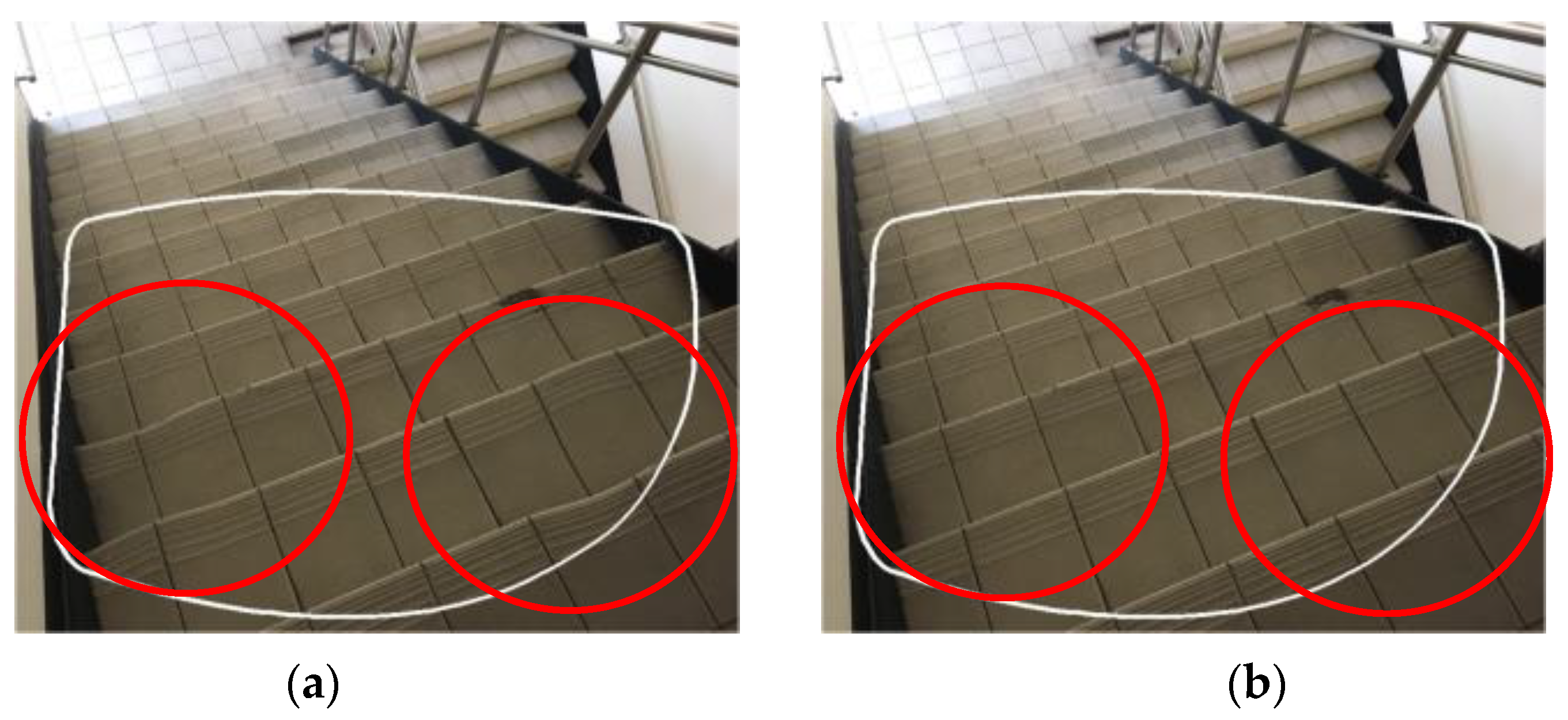


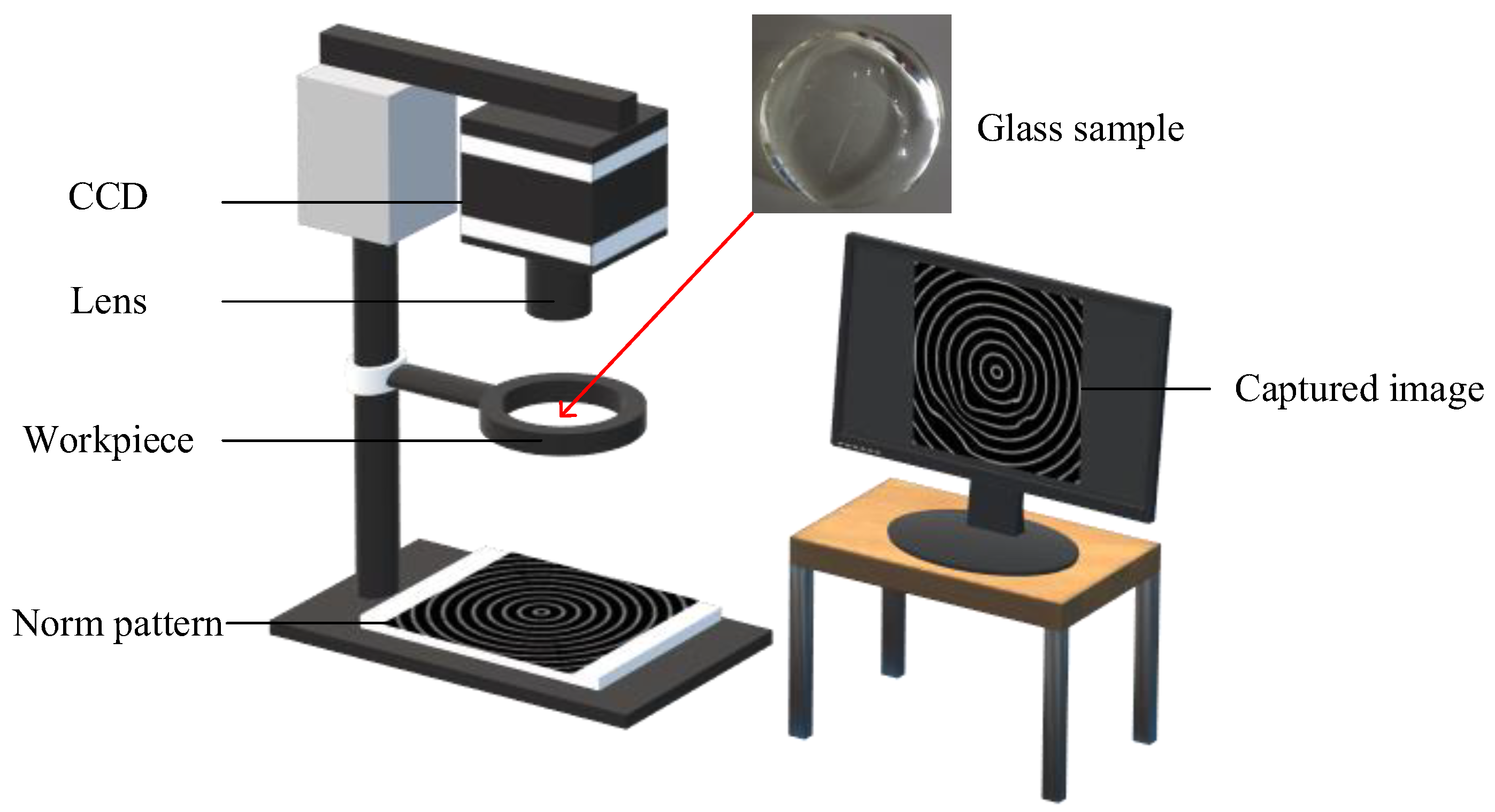
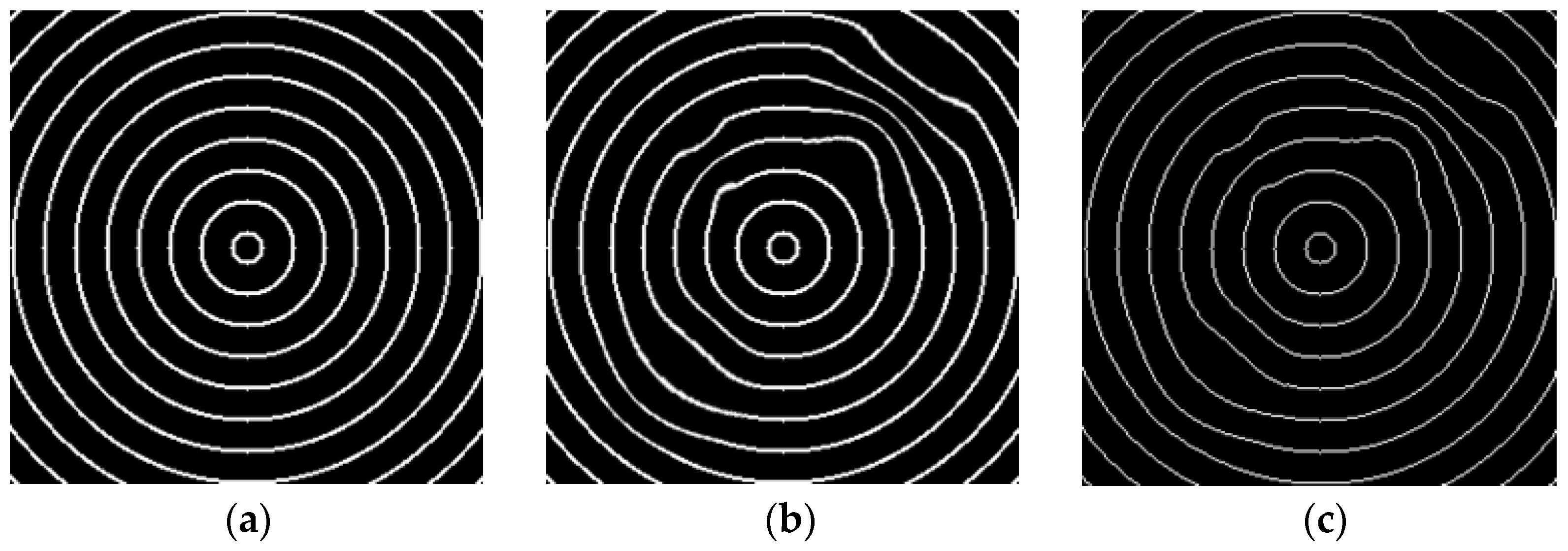
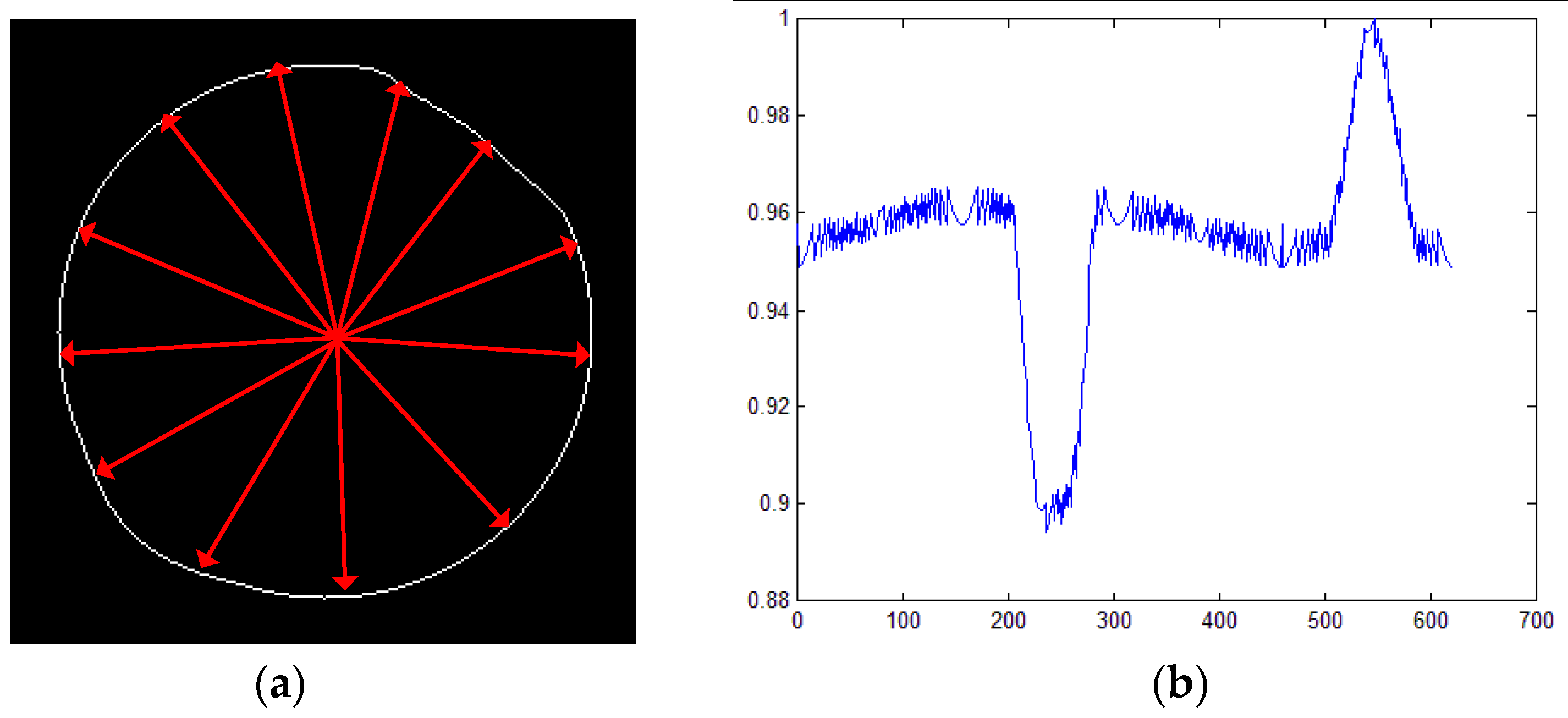



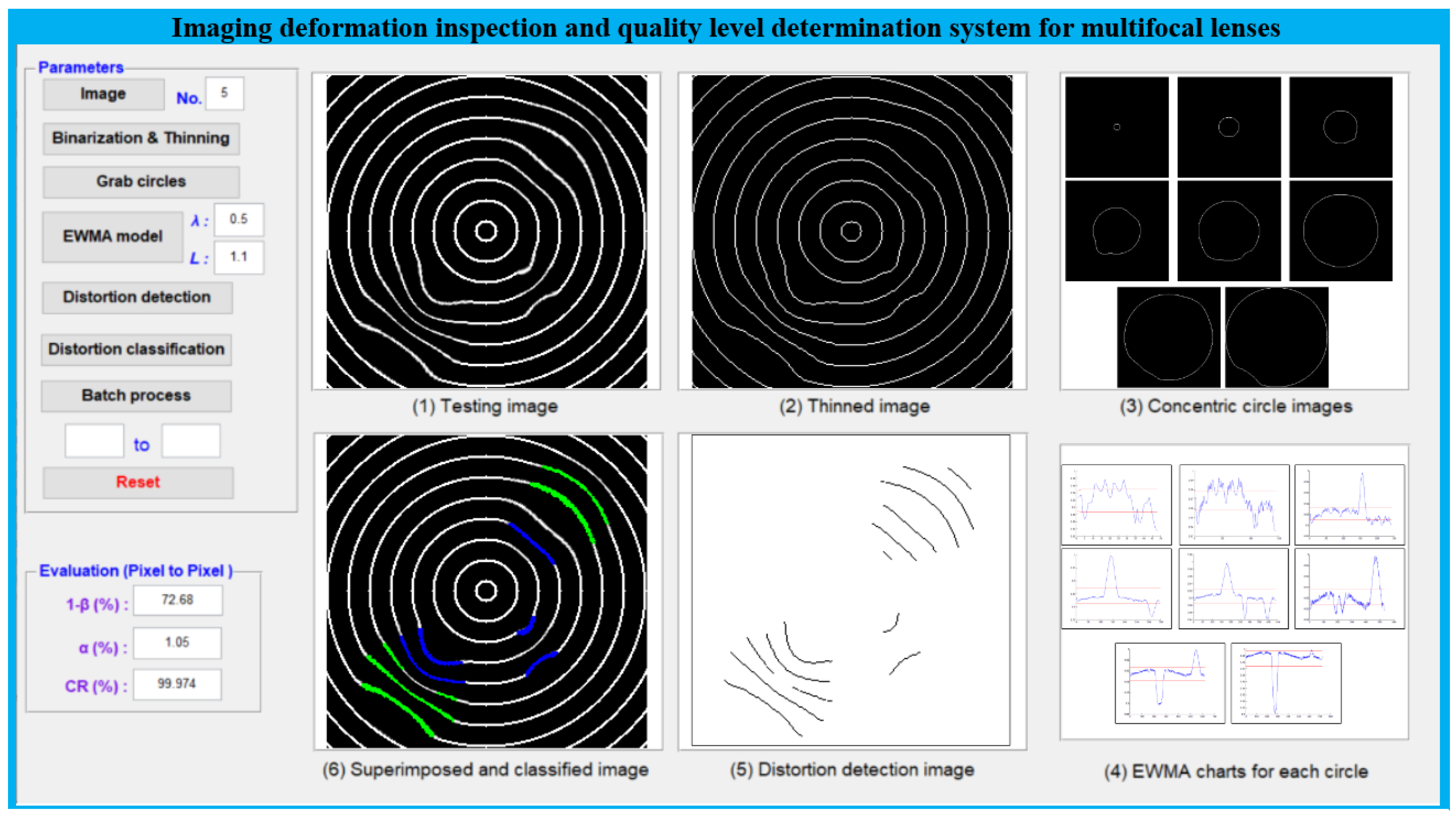


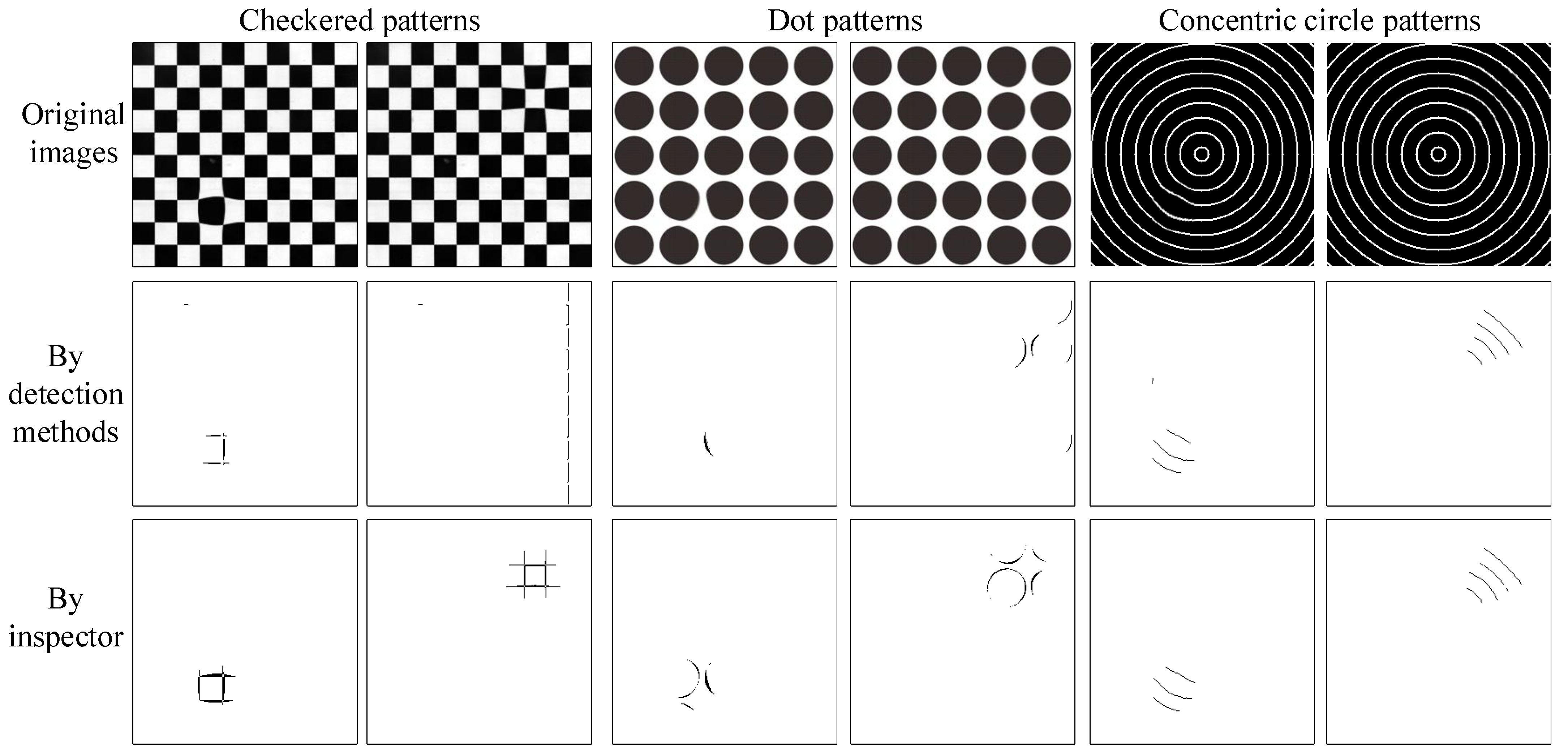


| Inputs | Outputs | |||
|---|---|---|---|---|
| Features | U1: Deformation measure in zone A | U2: Deformation measure in zone B | U3: Deformation measure in zone C | Y: Distortion levels |
| Degrees | A1: Small A2: Large | B1: Small B2: Medium B3: Large | C1: Small C2: Medium C3: Large | Y1: Slight Y2: Average Y3: Severe |
| Input Items | Membership Functions of Measures | Fuzzy Sets and Ranges of Measures |
|---|---|---|
| Deformation measure U1 in zone A | 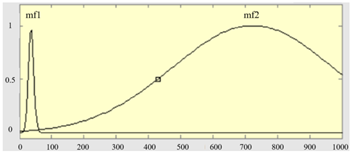 | |
| Deformation measure U2 in zone B |  | |
| Deformation measure U3 in zone C |  |
| Line Thicknesses | 1 Pixel | 2 Pixels | 3 Pixels | 4 Pixels | 5 Pixels | 6 Pixels |
|---|---|---|---|---|---|---|
| Recall (%) | 54.36 | 80.72 | 80.12 | 75.90 | 79.15 | 77.49 |
| Precision (%) | 94.93 | 96.02 | 96.02 | 90.47 | 95.32 | 91.06 |
| Deformation Detection Techniques | EWMA Control Scheme | ||
|---|---|---|---|
| Recall (%) | 81.09 | ||
| Precision (%) | 89.06 | ||
| Processing time (s) | 0.2847 | ||
| Quality level determination models | BPN | ANFIS | GA based ANFIS |
| Accuracy (%) | 70.00 | 70.67 | 94.00 |
| Norm Patterns | Hough Transform-Based Methods [22] | Concentric Circular Pattern | |
|---|---|---|---|
| Checkered Pattern | Dot Pattern | ||
| Recall (%) | 33.24 | 58.20 | 77.03 |
| Precision (%) | 37.64 | 81.22 | 76.86 |
| Accuracy (%) | 94.70 | 98.94 | 99.47 |
| Lighting Intervals | (μ − 3σ) | (μ − 2σ) | (μ − 1σ) | μ | (μ + 1σ) | (μ + 2σ) | (μ + 3σ) |
|---|---|---|---|---|---|---|---|
| Recall (%) | 70.46 | 77.38 | 80.35 | 89.81 | 82.54 | 71.93 | 64.49 |
| Precision (%) | 71.92 | 78.91 | 81.97 | 90.58 | 83.66 | 72.23 | 65.57 |
| Accuracy (%) | 99.89 | 99.92 | 99.92 | 99.96 | 99.93 | 99.89 | 99.87 |
Disclaimer/Publisher’s Note: The statements, opinions and data contained in all publications are solely those of the individual author(s) and contributor(s) and not of MDPI and/or the editor(s). MDPI and/or the editor(s) disclaim responsibility for any injury to people or property resulting from any ideas, methods, instructions or products referred to in the content. |
© 2023 by the authors. Licensee MDPI, Basel, Switzerland. This article is an open access article distributed under the terms and conditions of the Creative Commons Attribution (CC BY) license (https://creativecommons.org/licenses/by/4.0/).
Share and Cite
Lin, H.-D.; Lee, T.-H.; Lin, C.-H.; Wu, H.-C. Optical Imaging Deformation Inspection and Quality Level Determination of Multifocal Glasses. Sensors 2023, 23, 4497. https://doi.org/10.3390/s23094497
Lin H-D, Lee T-H, Lin C-H, Wu H-C. Optical Imaging Deformation Inspection and Quality Level Determination of Multifocal Glasses. Sensors. 2023; 23(9):4497. https://doi.org/10.3390/s23094497
Chicago/Turabian StyleLin, Hong-Dar, Tung-Hsin Lee, Chou-Hsien Lin, and Hsin-Chieh Wu. 2023. "Optical Imaging Deformation Inspection and Quality Level Determination of Multifocal Glasses" Sensors 23, no. 9: 4497. https://doi.org/10.3390/s23094497
APA StyleLin, H.-D., Lee, T.-H., Lin, C.-H., & Wu, H.-C. (2023). Optical Imaging Deformation Inspection and Quality Level Determination of Multifocal Glasses. Sensors, 23(9), 4497. https://doi.org/10.3390/s23094497








